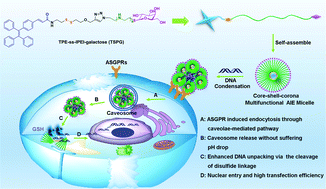Self-assembled core–shell-corona multifunctional non-viral vector with AIE property for efficient hepatocyte-targeting gene delivery†
Abstract
With the aim to develop a novel multifunctional gene delivery system that may overcome the common barriers of gene transfection, two amphiphilic molecules with tetraphenyl ethylene (TPE) as a hydrophobic moiety and linear PEI-galactose as a hydrophilic part were elaborately designed and synthesized. The molecules could self-assemble to form micelles and exhibited aggregation-induced emission (AIE) property, which may be used for cell imaging. Several assays revealed that the disulfide bond in TSPG may facilitate vector decomposition and DNA release, resulting in higher transfection efficiency and lower cytotoxicity than TCPG and PEI 25 kDa. These vectors showed excellent serum tolerance, and even higher efficiency could be obtained in transfection with the presence of serum. Moreover, the transfection in different cell lines showed that TSPG complex could induce higher gene expression in asialoglycoprotein receptor-rich HepG2 cells than in HeLa cells, which lack such receptors. Galactose competition assay also demonstrated that the galactose moiety could afford the vector with targeting ability toward hepatoma cells. Cellular uptake inhibition assay indicated that the DNA complex entered the cell mainly via caveolae-mediated endocytosis. Results showed that TSPG may serve as a promising reagent for simultaneous gene transfection and imaging with good biocompatibility and cell targeting ability.



 Please wait while we load your content...
Please wait while we load your content...